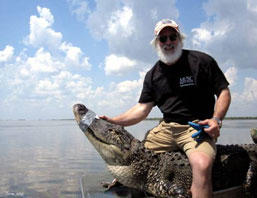Many chemicals introduced into the environment by humans adversely affect embryonic development of animals, including humans. A disruption of normal hormonal signals can permanently modify the organization and future function of the reproductive system. Over the last 20 years, Dr. Guillette has studied wildlife exposed to various environmental contaminants in aquatic ecosystems. His experiments, including those of the American alligator, are beginning to provide the causal relationships between embryonic pesticide exposure and reproductive abnormalities. The changes observed in wildlife are similar to changes in the human ovary that are associated with several prevalent diseases, but new measurement methods and quantitative approaches are critical for this research. Knowledge of the key indicators of exposure to contaminants is improving our understanding of the consequences of exposure during sensitive life stages in wildlife and humans.

Anyone outside NIST wishing to attend must be sponsored by a NIST employee and receive a visitor badge.
For more information, contact Stephanie Shaw at 301-975-2667.
Colloquia are videotaped and available in the NIST Research Library.
Louis J. Guillette, Jr.
Department of Obstetrics and Gynecology, Medical University of South Carolina & Hollings Marine Laboratory

